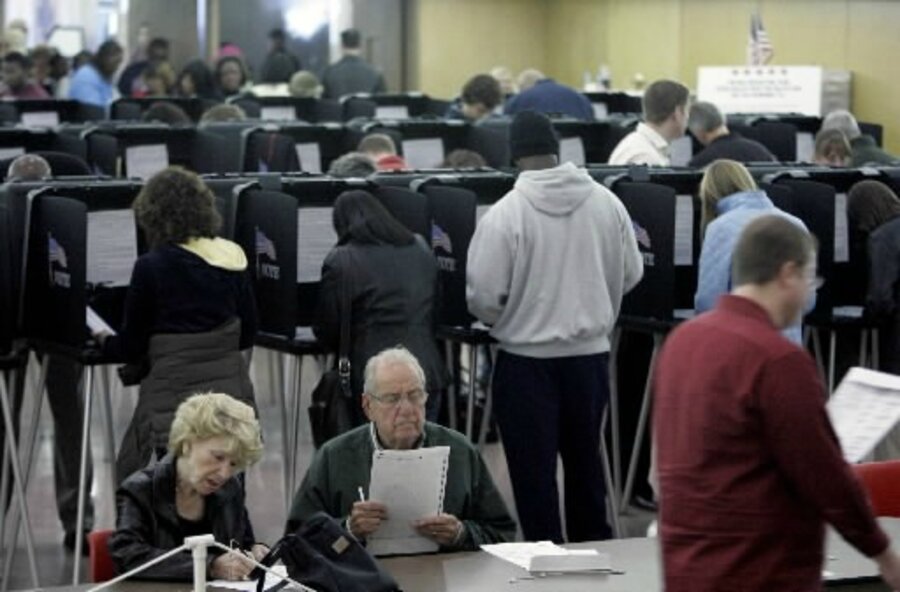Democrats edge past the GOP in party affiliation. Does it matter?
Loading...
Whether a voter identifies or leans toward a political party is becoming less and less relevant as the 2016 presidential election approaches.
Americans are more likely now than at any other time in recent history to avoid identifying themselves as Republican or Democrat, with 43 percent instead now calling themselves "independent," Gallup editor-in-chief Frank Newport reported in January, adding that the favorability rating for both major parties has dropped from 54 percent in 1993 to just 39 percent today.
Still, the way voters and potential voters register is closely watched by pundits and political pros, and the latest trend seems to favor Democrats.
In the second quarter of 2015, Democrats regained an advantage over Republicans in terms of party affiliation, Gallup reported last week. Forty-six percent of those surveyed identified as Democrats or said they are independents who lean toward the Democratic Party, while 41 percent identified as Republicans or leaned Republican.
In an analysis of the results, Gallup’s Jeffrey Jones describes recent shifts in party affiliation this way: “Republicans have seemingly lost the momentum they had going into last fall's elections, which saw them make significant gains in congressional seats, including taking partisan control of the Senate. After those victories, Americans' overall opinions of the Democratic Party worsened while the public grew slightly more positive toward the GOP.”
Republicans were able to maintain an even footing with Democrats through the first quarter of this year, Jones notes, but in the second quarter, the percentage of Democratic identifiers and leaners increased by three percentage points while the percentage of Republican identifiers and leaners decreased by three points. As a result, he concludes, Democrats are now back to where they were in 2013 and early 2014.
There may be several reasons for this.
The most obvious may be President Obama’s approval rating, which is getting better. He is his party’s leader, and recent political wins – a new trade bill in Congress, major Supreme Court victories on the Affordable Care Act and same-sex marriage, and the widespread positive response to his remarkable eulogy for nine African-American churchgoers slain by an avowed white racist in South Carolina – have boosted his standing, which reflects on his party.
As CNN reported last week: “After months of stagnant approval ratings, a new CNN/ORC poll finds that for the first time in more than two years, 50 percent of Americans approve of the way Obama is handling the presidency. And his overall ratings are bolstered by increasingly positive reviews of his treatment of race relations and the economy.”
(Other polls accumulated by Real Clear Politics show a slight majority of those surveyed disapproving of the job Obama is doing, although the recent trend is toward greater approval.)
Another factor in Democrats gaining ground on voter registration may be the party’s growing number of presidential candidates. Hillary Rodham Clinton leads in polling by a comfortable margin, but Vermont Senator Bernie Sanders has made a strong showing and several others – most recently former Virginia senator James Webb – are stirring the political pot and are likely to make for lively debates.
As Gallup’s Jones notes, “Democrats may be benefiting from having a well-known and relatively popular front-running candidate in Hillary Clinton, which paints a contrast to the large, fractured and generally less well-known field of Republican presidential candidates.”
Still, there’s plenty of time before most voters – including those yet to register – begin paying attention to the presidential race. Some may want to change their registration in order to vote in a specific primary election – especially in those states with closed primaries.
There have, of course, been several famous party-switchers in recent US political history.
Former Republican president Ronald Reagan, who started out as a Democrat and union leader (president of the Screen Actors Guild), famously said: “I didn’t leave my party, my party left me.” That was 1962, four years before he became governor of California.
More recently, billionaire real estate mogul and reality TV show personality Donald Trump has been all over the place on party affiliation.
Drawing on New York City Board of Elections records, The Smoking Gun reports that Mr. Trump initially registered as a Republican (in 1987), reenrolled as a member of the Independence Party (1999), became a Democrat (2001), switched back to the GOP (2009), changed his registration to read “I do not wish to enroll in a party” (2011), before registering once again as a Republican (2012).
Trump’s political fickleness – including the eight years he spent as a Democrat through George W. Bush’s two terms as president – appears not to be a turn-off for many Republican voters. Recent polls show him hovering around second place in early voting states Iowa and New Hampshire while holding his own mid-pack in general polling.
More obscurely, presidential candidate Lincoln Chaffee of Rhode Island won elections as a Republican and an Independent before switching to the Democratic Party.








